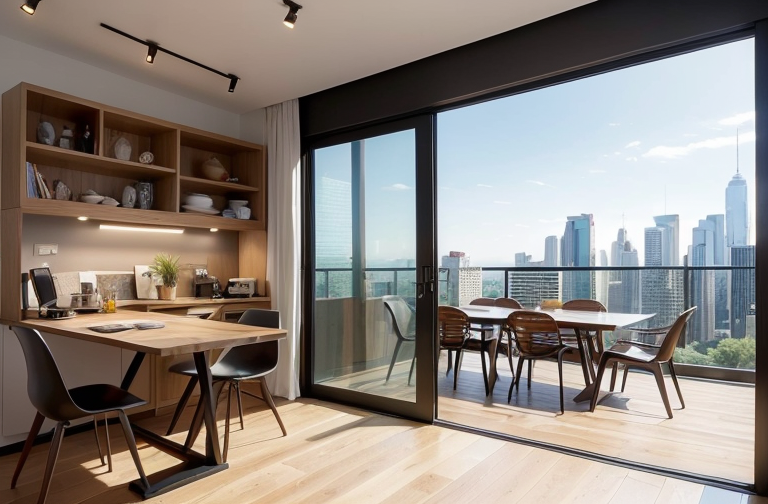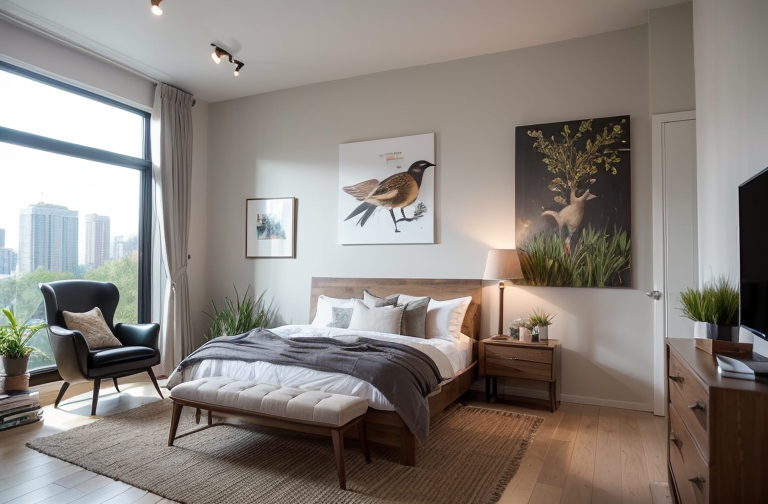Exploring the Core Principles and Evolving Trends of Industrial Interior Design

Industrial design values raw materials and neutrality with decor serving a functional purpose. It features exposed elements and strategic lighting, with furniture selection and color choices enhancing the design. The style is evolving with trends and fits well in urban lofts.
Understanding Industrial Design Principles
I’d love to share my insights on the principles of industrial design. Being an ardent design enthusiast and having focused my career on interior design, I’ve come to appreciate the uniqueness and functionality inherent in this style. One aspect I find particularly appealing in industrial decor is the focus on raw, unrefined materials, adding character to a space.
Importance of Raw and Unrefined Materials
In a typical industrial themed setting, there’s an intimate relationship between the space and the materials used. There’s an irresistible charm that comes with incorporating steel, brick, and wood in your small round house interior design, for instance. These raw, unrefined materials maintain their inherent characteristics while oozing a vibe of strength, resilience, and durability.
Emphasis on Neutral Tones
Industrial style is often linked with neutral, subdued tones think greys, blacks, and whites. It’s more than just a stylistic choice. Neutrality is pivotal in industrial design, creating a harmonious interplay between the different elements. The use of monochromatic colors brings out a chic, sophisticated feel.
Focus on Functional Decor
Another principle that resonates with me in industrial design is the heavy emphasis on improving a space’s practical functionality. In this design style, every decor item used is carefully selected, ensuring it serves a purpose beyond aesthetics. Whether it’s a comfortable leather couch or an iconic steel lamp, everything has a role to play, which is what creates a functional, liveable space.
The industrial design style is a testament to the notion that design isn’t merely about aesthetics, but also addresses the practical aspect of living. This type of interior design, with its emphasis on raw materials, neutral tones, and functional decor, ensures you enjoy both form and utility in your home.

Role of Lighting and Exposed Elements in Industrial Design
As an admirer of spaces that communicate distinct narratives, I find the industrial house design interior captivating with its emphasis on fundamentals such as strategic lighting and exposed elements. These elements are more than mere accents; they are vital to the essence of the design.
Importance of Strategic Lighting
Lighting, in particular, plays an integral role in this design style, spotlighting the architectural elements that define it. The interplay of shadows and light, whether natural or artificial, can accentuate the raw beauty of the design, evoke mood, and create depth in a space. Picture robust light fixtures illuminating a high ceiling warehouse style loft, casting a warm glow on the exposed beams and weathered brick. This sort of strategic illumination can truly bring an industrial design to life.
Significance of Exposed Elements
Equally significant in an industrial home are the exposed elements bricks, concrete, pipes, ducts. These elements are nod to the architectural history of industrial buildings keeping the authenticity intact. Be it the crude beauty of the brickwork, or the gritty aesthetic appeal of pipes and ducts, these details contribute to the inherent authenticity of the design that is so quintessential to industrial design interior.
Ensuring Authenticity with Design Choices
Part of the charm of industrial design lies in its unpretentious honesty – its ability to showcase the raw, unfinished elements with grace. In my projects, each feature – even the most minute and seemingly mundane one – is carefully chosen and positioned to resonate with this design ethos. To me, every pipe, every brick, every strip of steel is a canvas that narrates its own story.
In the grand scheme, it isn’t just about the aesthetic appeal, but about striking a balance between refinement and rawness, between the new and the old, light and shadow. And it’s this subtle harmony that takes an industrial house design interior from the realm of the ordinary into the extraordinary.

Making Informed Furniture Selections
As an interior design enthusiast, one of my deepest appreciations is the creative journey of curating the perfect collection of furniture for a design project. When it comes to emulating an industrial design house interior, furniture selection plays a substantial role in enhancing the overall industrial feel.
Enhancing Industrial Feel with Furniture
How you ask? For starters, choosing vintage metal and leather items can work wonders. These elements, time and time again, have proven to reflect the raw aesthetics that industrial design seeks to cherish. Just as it subtly hints at the era’s manufacturing heritage, it also helps in seamlessly combining practicality with edgy stylistic choices.
Emulating Factory Ambience
When creating an industrial ambiance, emulating the traditional factory ambience is a key strategy. As I’ve often found, wooden and parquet pieces can skillfully mirror the appeal. Remember, the factory was essentially a workspace. Therefore, incorporating elements reminiscent of a workspace not only enhances the industrial feel but also infuses a sense of authenticity.
Choosing Furniture Materials in Industrial Designs
Select your furniture materials with intention. Choose items that lack a heavily painted or heavily polished finish. Why? Because maintaining authenticity in industrial design often means embracing the imperfect and celebrating the raw materials. Think of it as allowing the furniture to narrate its own tale of creation.
Remember, successful design is about balance – creating a narrative where every element has a part to play, including your furniture selections.44

Trends and Evolutions in Industrial Design
As someone who’s been knee deep in the world of design for years, I’ve seen countless trends come and go. But when it comes to industrial interior house design, there’s no mistaking its timeless allure.
Incorporating Urban Loft Style Interiors
One trend I adore in industrial design is the application for urban loft style homes. With its grit meets glamor vibe, it’s an aesthetic that’s both adaptable and appealing to city dwellers. It introduces a versatile dimension to living spaces, capturing the soul of city life in its raw yet striking allure.
Keeping Abreast with Changing Trends
I’ve loved seeing the evolution of industry trends, particularly the fresh perspectives for incorporating industrial style into kitchen designs in 2023. Embracing its charm means championing a blend of exposed structural elements, sleek surfaces, and sturdy fixtures. It’s all about striking that balance between cool modernity and warm nostalgia in creating an inviting and dependable space for cooking up memorable meals.
Unique Decor Inspirations in Industrial Design
But it’s not just about the big elements. Even the subtle touches matter. Shapes present unique decor possibilities in industrial design settings, and I personally revel in this. Whether it’s bringing in geometric light fixtures, angular furniture, or circular wall accents, there’s plenty of wiggle room to sculpt an industrial space into a home that’s unapologetically you.
In the flurry of design trends, industrial style remains a notable mainstay. Its adaptability, evolving nature, and the unique decor opportunities it offers is a testament to its enduring charm. For those looking to craft an aesthetic that’s bold, practical, and captures the spirit of urban dwelling, it’s a design style worth exploring.
Enhancing Industrial Design with Color Use
I am of the view that color can play an incredibly influential role in industrial house design interior. It can deepen the textural richness and emotional resonance of the space while maintaining its functional practicality.
Embrace of Neutral Color Palettes
In the realm of industrial design, house interior design tends to gravitate towards neutral color schemes, which are both versatile and soothing. Taupe, grayscale, and earth tones are liberally used to introduce a sense of subtle sophistication and to let the architectural elements of your small round house interior design take the center stage.
Exploration of Material Diversity
Variety, as they say, is the spice of life, and this holds especially true for the industrial interior house design. Resourcefulness is a hallmark of this style, with a raft of unique materials characterized by their raw beauty being employed go perfectly with interior paints and primers. These, in turn, serve to augment and enhance the neutrality of the prevailing color scheme.
Incorporation of Distinct Colors
A common preconception is that the industrial design interior philosophy is confined to an array of muted colors. While earthy and neutral hues remain favored, there’s no limitation or reason to shy away from the bold and bright. I am a great advocate of incorporating distinct color options like shades offered by Benjamin Moore’s Aura Eggshell Paint. They can add a dash of vibrance and liveliness to the austere minimalism of the industrial aesthetic.
Ultimately, creating an effective industrial interior house design involves a deft interplay of diverse materials and thoughtful use of color. The result should be in sync with your distinctive personality and lifestyle, exuding an authentic charisma that turns your house into a home.
- Unlocking the Intricacies of Interior Design: Ranch-Style Homes and the Pursuit of Functionality
- Blending Tradition and Modernity: Exploring the Design of Nipa Hut and Trynagoal Tea House
- Enhancing Dining Experiences through Creative Interior Design and Rebranding in Burger Restaurants
- Mastering Home Renovation: The Crucial Roles of an Interior Designer and Effective Budget Management
- Understanding the Value of Interior Designers: Roles, Benefits, and Selection Process
- Exploring the Richness of Turkish Architecture and Interior Design through Adobe Stock and Pinterest
- Unveiling the Unique Characteristics and Design Elements of Ranch-Style Houses
- Embracing Openness and Personal Touch: The California Ranch House Interior Design Concept
- Embracing Warm Minimalism: The Rise of Brown Tones in Interior Design
- Enhancing Your New Home: Key Elements and Strategies in Interior Design
- Unveiling the Art of Luxury Interior Design: Exploration of Materials, Individual Style and Inspiration from Pinterest
- 13 Easy and Affordable Tips to Spruce Up Your Home Decor
- Exploring the Rich History and Distinctive Features of Tudor Architecture
- Exploring British Home Interiors: From Historical Evolution to Modern Adaptation
- Traversing the World of Interior Design: From Designer Profiles to DIY Ideas and Future-ready Furniture
- Contemporary Home Refinement: Leveraging Exposed Brick Design and Affordable, High-Quality Furnishings
- Exploring the Warmth and Charm of Modern Rustic Interior Design
- Enhancing Duplex and Triplex Interiors: An In-Depth Guide to Style, Lighting, and Effective Use of Space
- Creating Your Dream Bathroom: A Comprehensive Guide to Designs, Functionality, and Material Selection
- Creating Your Personal Spa: Insights into Modern Bathroom Design Trends



